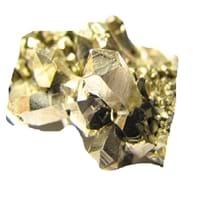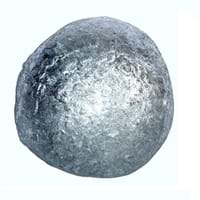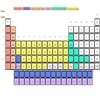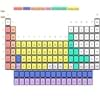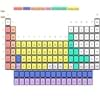Niobium vs Zinc
Periodic Table
Symbol
Nb
Zn
Group Number
5
13
12
6
Period Number
5
4
Block
d block
d block
Element Family
Transition Metal
Transition Metal
CAS Number
7440031
99+
7440666
24
Space Group Name
Im_ 3m
P63/mmc
Space Group Number
229.00
1
194.00
5
Facts
Interesting Facts
- Niobium metal was used to get called Columbium in past.
- Niobium metal found freely in nature (abundance).
- Zinc metal found (obtain) in many forms like granules, foil, dust and in a powder form.
- The leading producers of Zinc metal are Australia, Canada, China, U.S.A and Peru.
Sources
By-product of Tin Extraction, Found in Minerals, Mining, Ores of Minerals
Earth's crust, Found in Minerals, Mining, Ores of Minerals
History
Who Discovered
Charles Hatchett
Indian metallurgists
Discovery
In 1801
Before 1000 BCE
Abundance
Abundance In Universe
2 * 10-7 %
22
3 * 10-5 %
11
Abundance In Sun
~0.0000004 %
23
~0.0002 %
10
Abundance In Meteorites
0.00 %
35
0.02 %
12
Abundance In Earth's Crust
0.00 %
25
0.01 %
16
Abundance In Oceans
0.00 %
34
0.00 %
10
Abundance In Humans
Not Available
0.00 %
6
Uses
Uses & Benefits
- Niobium alloys are used in jet engines and rockets and spacecraft, beams and girders for buildings and oil and gas pipelines.
- It is used superconducting magnets in particles accelerators, NMR and MRI equipment.
- It is mainly used for Galvanizing other metals.
- It is also used for manufacturing die-casting and it is very essential for automobile industry.
Industrial Uses
Aerospace Industry, Ammunition Industry, Electrical Industry, Electronic Industry
Electrical Industry, Electronic Industry
Medical Uses
NA
Pharmaceutical Industry
Other Uses
Alloys
Alloys
Biological Properties
Toxicity
Low Toxic
Highly Toxic
Present in Human Body
Yes
Yes
In Blood
0.01 Blood/mg dm-3
25
7.00 Blood/mg dm-3
6
In Bone
0.07 p.p.m.
25
170.00 p.p.m.
6
Physical Properties
Melting Point
2,468.00 °C
6
419.58 °C
99+
Boiling Point
2,468.00 °C
99+
907.00 °C
99+
Appearance
Physical State
Solid
Solid
Color
Gray
Silvery Gray
Luster
Metallic
Metallic
Hardness
Mohs Hardness
6.00
6
2.50
14
Brinell Hardness
735.00 MPa
14
327.00 MPa
32
Vickers Hardness
870.00 MPa
12
Not Available
Speed of Sound
3,480.00 m/s
21
3,850.00 m/s
18
Optical Properties
Refractive Index
Not Available
1.00
2
Reflectivity
Not Available
80.00 %
5
Allotropes
No
No
α Allotropes
Not Available
Not Available
β Allotropes
Not Available
Not Available
γ Allotropes
Not Available
Not Available
Chemical Properties
Chemical Formula
Nb
Zn
Isotopes
Known Isotopes
17
22
25
14
Electronegativity
Pauling Electronegativity
1.60
23
1.65
19
Sanderson Electronegativity
1.42
16
2.23
6
Allred Rochow Electronegativity
1.23
25
1.66
7
Mulliken-Jaffe Electronegativity
Not Available
1.65
11
Allen Electronegativity
1.41
31
1.59
22
Electropositivity
Pauling Electropositivity
2.40
31
2.35
35
Ionization Energies
1st Energy Level
652.10 kJ/mol
99+
906.40 kJ/mol
6
2nd Energy Level
1,380.00 kJ/mol
99+
1,733.30 kJ/mol
27
3rd Energy Level
2,416.00 kJ/mol
99+
3,833.00 kJ/mol
12
4th Energy Level
3,700.00 kJ/mol
99+
5,731.00 kJ/mol
11
5th Energy Level
4,877.00 kJ/mol
36
7,970.00 kJ/mol
9
6th Energy Level
9,847.00 kJ/mol
11
10,400.00 kJ/mol
9
7th Energy level
12,100.00 kJ/mol
14
12,900.00 kJ/mol
9
8th Energy Level
Not Available
16,800.00 kJ/mol
6
9th Energy Level
Not Available
19,600.00 kJ/mol
8
10th Energy Level
Not Available
23,000.00 kJ/mol
10
11th Energy Level
Not Available
26,400.00 kJ/mol
11
12th Energy Level
Not Available
29,990.00 kJ/mol
11
13th Energy Level
Not Available
40,490.00 kJ/mol
5
14th Energy Level
Not Available
43,800.00 kJ/mol
6
15th Energy Level
Not Available
47,300.00 kJ/mol
8
16th Energy Level
Not Available
52,300.00 kJ/mol
9
17th Energy Level
Not Available
55,900.00 kJ/mol
10
18th Energy Level
Not Available
59,700.00 kJ/mol
11
19th Energy Level
Not Available
67,300.00 kJ/mol
10
20th Energy Level
Not Available
171,200.00 kJ/mol
1
21st Energy Level
Not Available
179,100.00 kJ/mol
1
Electrochemical Equivalent
0.69 g/amp-hr
99+
1.22 g/amp-hr
99+
Electron Work Function
4.30 eV
18
4.33 eV
17
Other Chemical Properties
Anti Corrosion, Ionization, Radioactive Isotopes, Solubility
Anti Corrosion, Chemical Stability, Ionization, Radioactive Isotopes
Atomic Properties
Atomic Number
41
99+
30
99+
Electron Configuration
[Kr] 4d4 5s1
[Ar] 3d10 4s2
Crystal Structure
Body Centered Cubic (BCC)
Hexagonal Close Packed (HCP)
Crystal Lattice
BCC-Crystal-Structure-.jpg#100
HCP-Crystal-Structure-of-Zinc.jpg#100
Atom
Number of Protons
41
99+
30
99+
Number of Neutrons
52
99+
35
99+
Number of Electrons
41
99+
30
99+
Radius of an Atom
Atomic Radius
146.00 pm
35
134.00 pm
99+
Covalent Radius
164.00 pm
28
122.00 pm
99+
Van der Waals Radius
200.00 pm
28
139.00 pm
99+
Atomic Weight
92.91 amu
99+
65.38 amu
99+
Atomic Volume
10.87 cm3/mol
99+
9.20 cm3/mol
99+
Adjacent Atomic Numbers
Valence Electron Potential
104.00 (-eV)
8
38.90 (-eV)
99+
Lattice Constant
330.04 pm
99+
266.49 pm
99+
Lattice Angles
π/2, π/2, π/2
π/2, π/2, 2 π/3
Lattice C/A Ratio
Not Available
Not Available
Mechanical Properties
Density
Density At Room Temperature
8.57 g/cm3
99+
7.14 g/cm3
99+
Density When Liquid (at m.p.)
Not Available
6.57 g/cm3
37
Tensile Strength
330.00 MPa
12
Not Available
Viscosity
Not Available
Not Available
Vapor Pressure
Vapor Pressure at 2000 K
0.00 (Pa)
27
Not Available
Elasticity properties
Shear Modulus
38.00 GPa
19
43.00 GPa
18
Bulk Modulus
170.00 GPa
10
70.00 GPa
19
Young's Modulus
105.00 GPa
20
108.00 GPa
19
Poisson Ratio
0.40
4
0.25
24
Other Mechanical Properties
Ductile, Malleable
NA
Magnetic Properties
Magnetic Characteristics
Specific Gravity
8.57
37
6.90
99+
Magnetic Ordering
Paramagnetic
Diamagnetic
Electrical Properties
Electrical Property
Conductor
Conductor
Resistivity
152.00 nΩ·m
23
59.00 nΩ·m
40
Electrical Conductivity
0.07 106/cm Ω
28
0.17 106/cm Ω
12
Electron Affinity
86.10 kJ/mol
12
0.00 kJ/mol
40
Thermal Properties
Specific Heat
0.26 J/(kg K)
20
0.39 J/(kg K)
14
Molar Heat Capacity
24.60 J/mol·K
99+
25.47 J/mol·K
39
Thermal Conductivity
53.70 W/m·K
29
116.00 W/m·K
14
Critical Temperature
Not Available
Not Available
Thermal Expansion
7.30 µm/(m·K)
99+
30.20 µm/(m·K)
11
Enthalpy
Enthalpy of Vaporization
696.60 kJ/mol
4
7.32 kJ/mol
99+
Enthalpy of Fusion
27.20 kJ/mol
6
7.32 kJ/mol
99+
Enthalpy of Atomization
745.00 kJ/mol
4
129.70 kJ/mol
99+
Standard Molar Entropy
36.40 J/mol.K
99+
41.60 J/mol.K
36
|
||
|
||
|
